Commonwealth, NSW
COMMONWEALTH GOLD-SILVER-BASE METAL PROJECT (IPT 100%)
Impact’s 100% owned Commonwealth project lies within the prolific Lachlan Fold Belt copper-gold province in New South Wales home to many world class gold and copper projects (Figure 1).
The province is prospective for a wide range of mineral deposits including porphyry copper-gold (e.g. Cadia-Ridgeway), epithermal gold (Cowal) and volcanogenic massive sulphide (VMS) deposits (Woodlawn).
Impact’s work was focussed initially on the Commonwealth VMS deposit but attention has recently turned to porphyry copper-gold exploration following the recent significant Boda copper-gold discovery located a few kilometres north of Impact’s ground holdings (Alkane Resources Limited).
Porphyry Copper Gold Exploration
Relevant ASX announcements by Impact were released on 22nd August 2019, 22nd November 2019, 23rd April 2020 and 23rd June 2020.
Four prospects, Boda South, Apsley, Spicers Creek and Greenobbys were the focus of work and were identified from reconnaissance field checking, new rock chip assays and interpretation of regional magnetic data. This work was prompted by the Boda discovery (Figures 2 and 3).

Figure 1. Location of Impact’s Commonwealth, Pine Hill and Day Dawn Projects covering about 900 km2 of the Lachlan Fold Belt of NSW, home to many significant gold and copper mines.
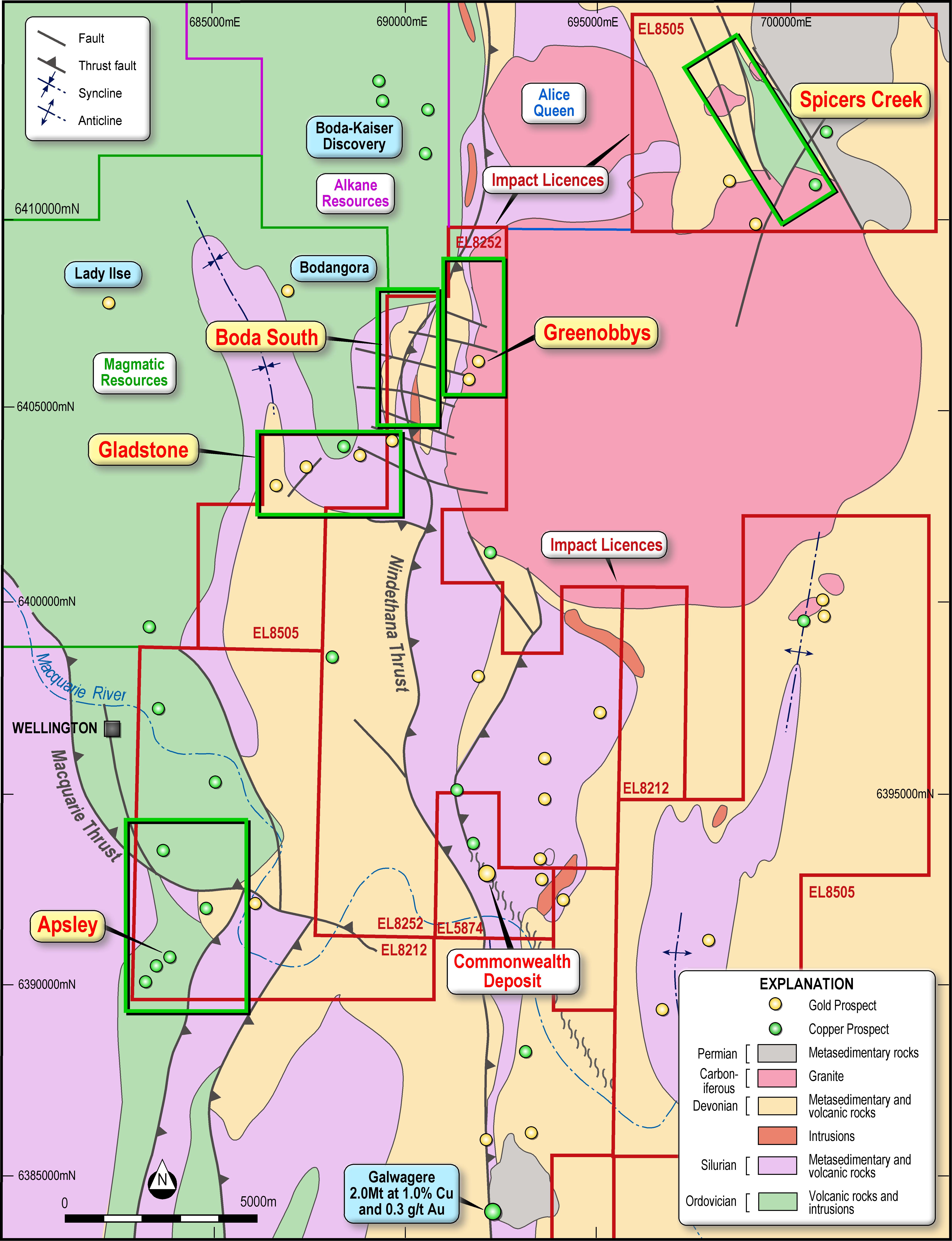
Figure 2. Priority prospects for follow up work and geology of the Commonwealth Project. Note the location of the Boda-Kaiser prospects (Alkane Resources) and the Lady Ilse prospect (Magmatic Resources Limited.
At Boda, which lies immediately along trend from Impact’s tenements, a significant drill intercept of 1,167 metres at 0.55 g/t gold and 0.25% copper including a higher grade “core” of 96.8 metres at
4 g/t gold and 1.5% copper was recently reported (ALK ASX Release 23rd March 2020).
The Boda deposit is currently about 400 metres wide (true width), shows strong zonation of metals and alteration minerals with higher grade copper-gold associated with magnetite in so called skarn-related alteration. The magnetite can be identified as an anomaly in regional magnetic data
(ALK ASX Release 23rd March 2020).
In addition, Alkane has shown that Boda is hosted by rocks of a specific high potassium alkaline geochemistry called shoshonites. Importantly these are of the same chemistry and age (Ordovician) as the host rocks at Cadia-Ridgeway and North Parkes (Figure 1) and are generally accepted as crucial components to the formation of giant porphyry copper-gold deposits globally.
All four of Impact’s prospects have characteristics suggesting they are parts of large porphyry or other intrusive-related copper-gold systems including:
- Significant copper and/or gold with associated pathfinder metals in recent rock chip assays.
- Alteration minerals that suggest they lie within the outer (propylitic) to middle-inner (potassic) zones of such intrusive-related systems, the prospective centres of which may lie only within a few hundred metres of the areas sampled, either at depth or along trend; and
- A spatial association with unexplained magnetic anomalies and which, like Boda, could be a direct indication of significant copper-gold mineralisation.
ORDOVICIAN COPPER-BEARING SHOSHONITES AT APSLEY, SPICERS CREEK AND BODA SOUTH
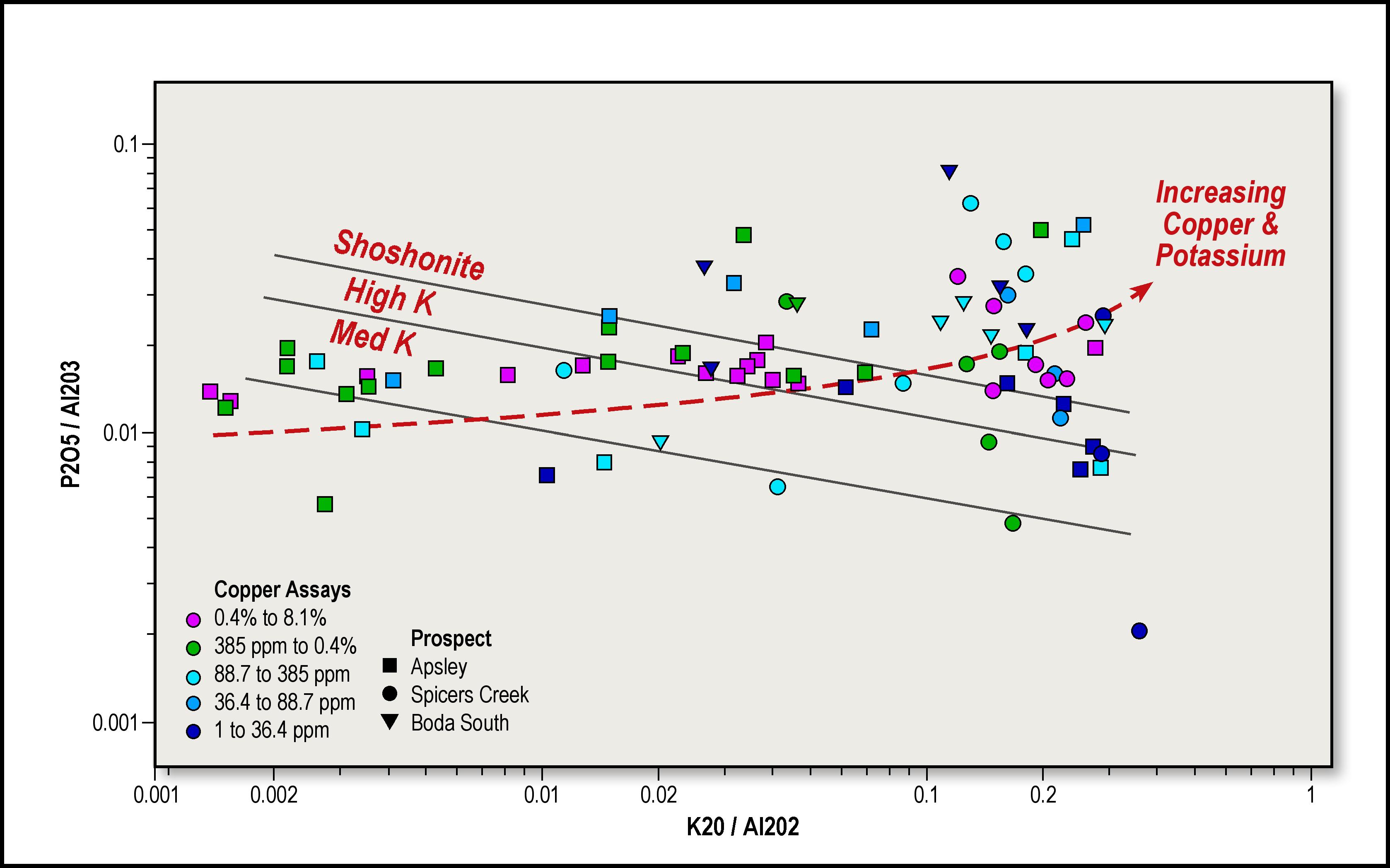
Figure 3. Major element ratio plot for Boda South (triangles) together with Apsley (squares) and Spicers Creek (circles) with copper results coloured by grade. An igneous differentiation trend towards copper-bearing high potassium-shoshonite rocks is evident; this is common to major porphyry copper deposits in the Lachlan Fold Belt.
New rock chip data and maps from the Geological Survey of New South Wales confirm that there are extensive areas of copper-rich shoshonite and related high potassium rocks of Ordovician age at the Apsley, Spicers Creek and Boda South prospects (Figure 3).
In addition, standard element ratio plots show that the shoshonites are also part of an igneous differentiation trend in which the rocks become more potassic (K2O-bearing) and, very importantly, more copper-rich as they evolve towards shoshonite compositions (Figure 3).
Furthermore, the prospects also have extensive areas of copper+/-gold mineralisation as well as important pathfinder metal assemblages and alteration mineral assemblages typical of porphyry copper gold systems as described separately for each prospect below.
These features constitute a major breakthrough for Impact as it indicates that many of the crucial fundamental components required to form a large porphyry copper-gold deposit are present at these prospects.
APSLEY
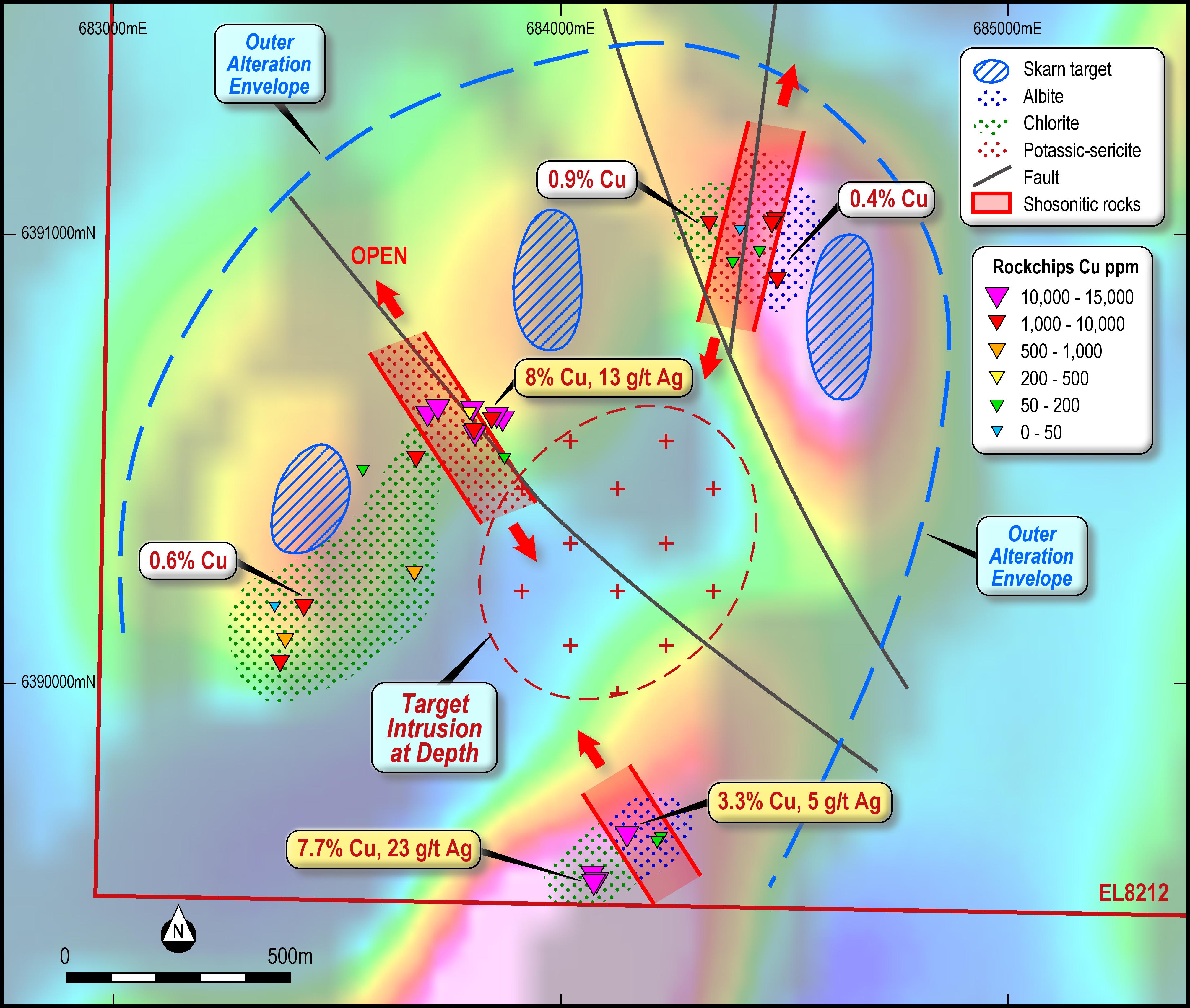
Figure 4. Airborne magnetic image (RTP 2VD) of the Apsley Prospect with copper assay results, interpreted alteration zones and possible parent intrusion at depth. The anomalous copper samples are adjacent to the magnetic anomalies which may represent skarn mineralisation.
Warmer colours on the image represent stronger magnetic responses.
A highly prospective target zone of about 2 square kilometres in size that has not been previously drilled has now been identified at Apsley.
The Apsley target is centred 8 km south of Wellington and covers a number of magnetic anomalies within Ordovician basalts and andesites (Figures 2 and 4). These are direct analogies to the magnetic response at Boda associated with the skarn mineralisation and parent porphyry intrusion (Figure 4).
Impact’s work indicates that a major copper mineralised system is present at the prospect, potentially sourced from a buried porphyry intrusion with high grade copper-gold mineralisation that may lie within a few hundred metres from surface (Figure 4).
Key features identified at Apsley by Impact include:
- Widespread and abundant copper oxides and fresh copper sulphides (malachite, azurite, chalcopyrite and bornite) which occur over at least a 2 square kilometre sized area with rock chip assays of up to 8.1% copper and 23 g/t silver with associated anomalous molybdenum, tellurium, tungsten and gold in places (Figure 4, Figure 5 and Table 1).
- The alteration mineral and pathfinder metal assemblages are mostly typical of the outer distal zones of porphyry copper systems (Figure 5: chlorite-albite (propylitic) alteration with pathfinder metal assemblages of Tl-Li-Sb-As and Cu-Bi-Te-Se). Copper is widespread in the outer zones of many porphyry copper gold deposits, for example North Parkes.
- Higher grade copper assays occur in focussed zones of more proximal sericite-potassic altered shoshonites and related high potassium rocks. These zones are interpreted to lie along faults that have tapped a mineralised intrusion at depth (Figures 4 and 6).
- The entire area of extensive copper mineralisation is associated with several significant magnetic anomalies which may represent skarn assemblages or parent porphyry intrusions directly associated with higher grade mineralisation at depth.
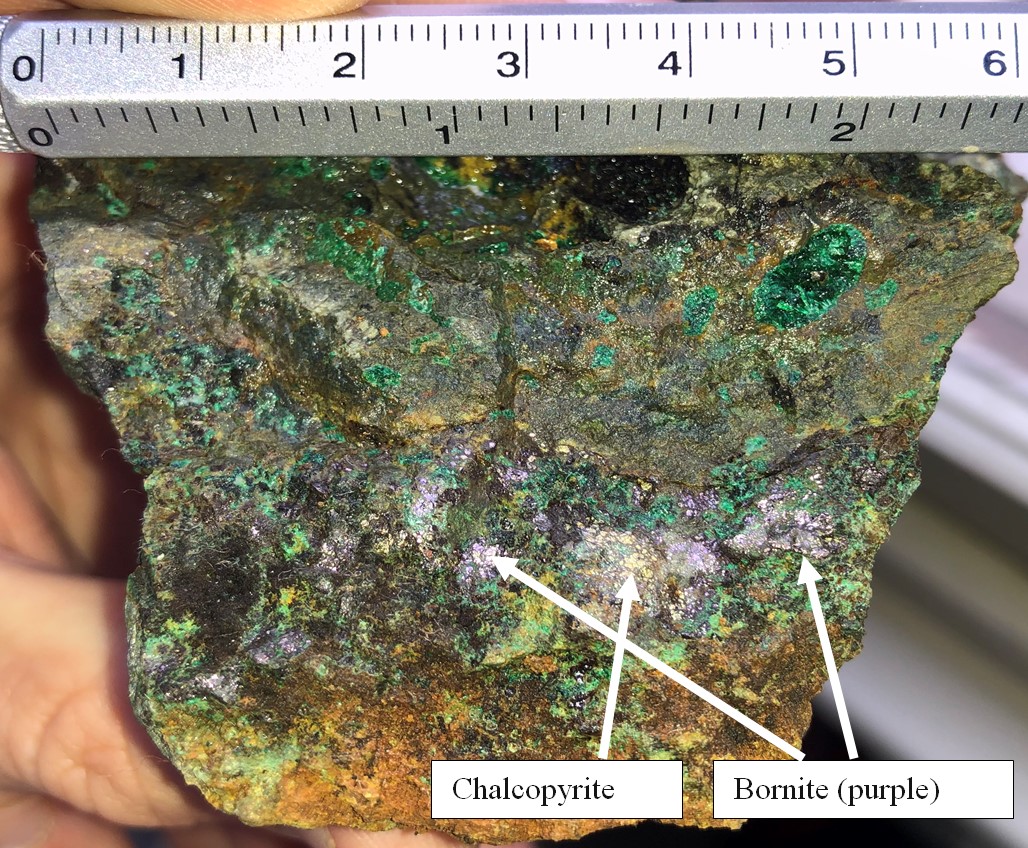
Figure 5. Apsley Prospect: Sample AP01: volcanic rock with extensive bornite (purple) and chalcopyrite (yellow) as well as copper oxides and carbonates (green) within moderately magnetic volcanic rock.
Figure 6. Industry-standard Feldspar-Sodium (Na)-Potassium (K) General Element Ratio plots showing alteration minerals (left) and the same samples coloured by copper results (right) for Apsley (squares) and Spicers Creek (circles). A clear trend of increasing copper towards more proximal inner alteration assemblages is very evident and consistent with being related to significant porphyry copper-gold systems (note the two prospects are many kilometres apart and thus two separate systems are present).
SPICERS CREEK
The Spicers Creek target occurs in the north east of the Commonwealth project and comprises a number of intriguing magnetic anomalies within Ordovician and Devonian volcanic and intrusive rocks (Figures 2 and 7).
A highly prospective target zone about 200 metres wide and at least 1,000 metres long has been identified at the south eastern part of the Spicers Creek prospect which is undrilled (Figure 7).

Figure 7. Image of magnetic data showing rock chip assay results, interpreted alteration zones and underlying geology at the Spicers Creek prospect. Warm colours in the magnetic image represent zones of stronger magnetic response.
Key features identified at Spicers Creek by Impact include:
A key driver in the exploration for large porphyry copper-gold deposits is to develop an understanding of the nature and distribution of the distinct zones of commodity metals, pathfinder metals and associated alteration minerals that form around such deposits in order to provide vectors to the high grade cores.
The zones, which are well understood in the scientific literature, vary from outer (distal) zones commonly characterised by chlorite-albite-epidote (propylitic) alteration and pathfinder metals such as antimony-arsenic-lithium-bismuth-tellurium-silver; to middle-inner zones (proximal) characterised by sericite-K feldspar (potassic) alteration and the pathfinder metals molybdenum-gold-copper-tungsten-tin.
These zones can be readily identified in industry-standard geochemical graphs such as potassium-aluminium-sodium molar ratio plots shown here (46 samples in total for Apsley and 23 samples from Spicers Creek).
GEOCHEMICAL EXPLORATION FOR PORPHYRY COPPER-GOLD DEPOSITS
- Copper oxides and fresh copper sulphides (chalcopyrite, chalcocite, bornite, azurite, and malachite) occur intermittently over 700 metres of trend within a zone at least 1,000 metres long and up to 200 metres wide that contains smoky quartz veins within epidote-garnet skarn altered mafic schists with later cross-cutting porphyry dykes.
One stand-out rock chip sample returned 6.8 g/t gold, 14.4% copper and 83 g/t silver with strongly elevated molybdenum (46 ppm), bismuth (185 ppm), tellurium (18 ppm) and tungsten (88 ppm). The other rock chip samples returned values of up to 132 ppb gold, 4.7 g/t silver and 0.7% copper.
- The alteration mineral assemblages indicate strong moderate to strong sericite alteration of shoshonite and related rocks and this is associated with the strongest copper results (Figure 6). The pathfinder metal assemblages of moderately elevated Tl-Li-Sb-As, Bi-Te-Se and Cu-Au-Bi-Mo is a mix of both outer and inner assemblages. This suggests the alteration zones have been “telescoped” along a fault that may have tapped a mineralised intrusion at depth or along trend.
- The magnetic data indicates the prospect area sampled is coincident with a broad weak linear magnetic anomaly about 1,000 metres long. Several other much stronger unexplained magnetic anomalies up to 1,000 metres long occur in the northwest of the prospect area and all of these are targets for skarn-related mineralisation (Figure 7). Further work along trend to the north west is required.
BODA SOUTH PROSPECT

Figure 8. Airborne magnetic image of the Boda South and Greenobbys Prospects with gold assay results and interpreted alteration zones. Warmer colours on the image represent stronger magnetic responses.
The Boda South prospect, which is undrilled, covers the faulted southern contact of the Boda Intrusive Complex (BIC), host to the Boda-Kaiser mineralisation and which is Ordovician in age (Figures 2 and 8). As demonstrated at Apsley and Spicers Creek, Boda South also contains the fundamental characteristics required to potentially host a significant porphyry copper-gold deposit:
- Copper-bearing Ordovician shoshonites with weak to moderate copper assays of up to 0.1% with copper increasing as the rocks become more potassium rich (shoshonitic - Figure 2).
- Metal assemblages of up to 40 ppm bismuth and 21 ppm tellurium as well as moderate epidote-chlorite alteration indicate the area may lie in the upper phyllic to outer (propylitic) zone of a porphyry copper-gold system. Typical values of both these pathfinders documented above known deposits are in the order of about 1 to 5 ppm.
- An association with two sub-parallel magnetic anomalies within the BIC as evident in regional magnetic data (Figure 8). This is a similar position to the Boda deposit, located about 3,000 metres along trend to the north, where the high grade copper-gold mineralisation discovered by Alkane also occurs between two magnetic units of the BIC (Figure 2 and ASX:ALK Release 23rd March 2020).
Given the prospective nature of the BIC, modelling of magnetic data is required to determine the depth to the intrusive complex at Boda South.
NEXT STEPS FOR PORPHYRY COPPER-GOLD
Impact’s work strongly supports the potential for the Commonwealth Project to host not only significant porphyry copper-gold deposits but also intrusion-related epithermal gold-silver deposits. Further work is now required to refine and rank these target areas for drilling.
At present, the Apsley target is ranked as the most prospective and a detailed soil geochemistry survey was completed in June 2000 and an IP survey in November 2020. Interpretation of the results is in progress and drill targets have been identified for testing in early 2021.
In addition, a detailed airborne magnetic and radiometric survey covering Impact’s priority areas was also completed recently and a detailed interpretation of that data is also in progress.
All of this new data will be interpreted and synthesised to help define follow up work programmes which will include drilling in 2020 and 2021.
VMS EXPLORATION
COMMONWEALTH AND SILICA HILL DEPOSITS
During the year Impact announced a significant increase in resources at the Commonwealth gold-silver-zinc-lead-copper deposit including a maiden resource for the silver-rich Silica Hill prospect (Figure 8) (ASX Release August 22nd 2019).
The new resource contains 88,800 ounces of gold and 3.3 million ounces of silver all of which occurs from surface to a depth of 250 metres and well within range of potential open pit mining.
The Mineral Resources at Commonwealth and Silica Hill have been prepared in accordance with the JORC 2012 Code by independent resource consultants Optiro and follows several drill programmes across the project area completed in late 2018.
The updated Inferred Resource for the Commonwealth deposit at a cut-off of 0.5 g/t gold is (Figure 9):
| COMMONWEALTH (MAIN SHAFT TO COMMONWEALTH SOUTH |
|
Resource
Classification
Cut-off 0.5 g/t gold |
Tonnes |
Gold (g/t) |
Contained gold (oz) |
Silver
(g/t) |
Contained
silver (oz) |
Zinc
(%) |
Lead
(%) |
Copper
(%) |
| Inferred |
912,000 |
2.4 |
70,800 |
44 |
1,300,000 |
1.20% |
0.50% |
0.08 |
A separate Inferred Mineral Resource (included within the overall resource) has also been calculated for the massive sulphide lens at Main Shaft alone to demonstrate the high grade nature of such deposits that are the principal target for Impact’s exploration programme. The Main Shaft Inferred Resource is:
| MAIN SHAFT MASSSIVE SULPHIDE LENS |
|
Resource
Classification
Cut-off 0.5 g/t gold |
Tonnes |
Gold (g/t) |
Contained gold (oz) |
Silver
(g/t) |
Contained
silver (oz) |
Zinc
(%) |
Lead
(%) |
Copper
(%) |
| Inferred |
142,000 |
4.5 |
20,600 |
161 |
737,500 |
4.6 |
4.6 |
0.2 |
At Silica Hill the maiden Inferred Resource at a 50 g/t silver cut-off is:
| SILICA HILL |
Resource
Classification
Cut-off 50 g/t gold |
Lode |
Tonnes (t) |
Silver
(g/t) |
Contained silver (oz) |
Gold
(g/t) |
Contained gold (oz) |
| Inferred |
North |
397,000 |
89 |
1,136,000 |
1 |
12,900 |
| Inferred |
South |
313,000 |
87 |
871,000 |
0.5 |
5,100 |
| |
TOTAL |
710,000 |
88 |
2,007,000 |
0.8 |
18,000 |
The resources are open along trend and at depth and extensive further resource definition and extensional drilling is required to follow up key intercepts at Main Shaft, Commonwealth South and Silica Hill as outlined below.

Figure 9. Block model of the resource from Commonwealth South (left) to Main Shaft (right). The high-grade blocks in red and pink show that the deposit is open along trend and at depth.
FURTHER EXPLORATION AT MAIN SHAFT

Figure 10.Location of drill assays from the 2018 drill programme at Main Shaft and Silica Hill (yellow labels). The Main Shaft resource is labelled “Massive Sulphide Resource”. The Silica Hill Prospect is in the centre of the map.
At Main Shaft the massive sulphide lens is still open at depth and along trend to the north and south east. For example the resource is open to the north down plunge from drill hole CMIPT084 and at depth below drill holes CMIPT021 and CMIPT082 (Figures 10 and 11).
Hole CMIPT084 returned:
5.7 metres at 3.8 g/t gold, 347 g/t silver, 10.8% zinc and 3.7% lead from 52.1 metres down hole; including 0.7 metres at 15.6 g/t gold, 245 g/t silver, 8.6% zinc and 1.9% lead;
and 0.5 metres at 4.9 g/t gold, 917 g/t silver, 10.2% zinc and 4.6% lead from 56.9 metres.
Hole CMIPT021 returned:
8.1 metres at 6 g/t gold, 193 g/t silver, 5.9% zinc, 2.3% lead and 0.16% copper from 71 metres
including 2.9 metres at 9.3 g/t gold, 201 g/t silver, 11.6% zinc, 4.7% lead and 0.2% copper.
Hole CMIPT083 returned:
4 metres at 3.3 g/t gold 129 g/t silver, 7% zinc and 1.9% lead from 96.4 metres down hole;
including 2.1 metres at 5.1 g/t gold, 239 g/t silver, 12.8% zinc and 3.5% lead.
In addition Hole CMIPT083 at Main Shaft also intersected a narrow high grade massive sulphide unit about 30 metres below the Main Shaft unit and together with other drill holes confirms the discovery of a second massive sulphide unit that is at least 100 metres by 150 metres in dimension and is untested at depth (Figures 10 and 12).
The second massive sulphide unit returned:
1 metre at 3.1 g/t gold, 57 g/t silver, 9.4% zinc and 4.2% lead and 0.2% copper from 143 metres down hole; including 0.3 metres at 0.8 g/t gold, 150 g/t silver, 30.2% zinc and 13.5% lead.
 Figure 11. Long section through the upper zone of mineralisation along the Commonwealth deposit and showing significant areas that require drill testing.
Figure 11. Long section through the upper zone of mineralisation along the Commonwealth deposit and showing significant areas that require drill testing.
 Figure 12. Second massive sulphide unit in Hole CMIPT083: massive and brecciated massive sphalerite (red-brown) with lesser galena. Up to 3% chalcopyrite (yellow) is present in places.
Figure 12. Second massive sulphide unit in Hole CMIPT083: massive and brecciated massive sphalerite (red-brown) with lesser galena. Up to 3% chalcopyrite (yellow) is present in places.
FURTHER EXPLORATION AT COMMONWEALTH SOUTH
At Commonwealth South, at the southern end of the Commonwealth Resource, two diamond drill holes completed in late 2018 identified significant extensions to the near-surface resource both along trend and at depth (Figures 11 and 13).
Hole CMIPT086 returned:
8 metres at 5.1 g/t gold, 20 g/t silver, 1.3% zinc and 0.5% lead from 94 metres down hole;
including 5 metres at 7.7 g/t gold, 25 g/t silver 2.1% zinc and 0.7% lead;
which includes 0.5 metres at 34.3 g/t gold, 40 g/t silver, 5.8% zinc and 2.3% lead from 97.6 metres.
Hole CMIPT087 returned:

Figure 13. Commonwealth South. NE-SW Cross-section showing drill results for Holes 086 and 087 and showing upper and lower zones of mineralisation
6 metres at 1.5 g/t gold, 22 g/t silver, 0.7% zinc and 0.2% lead from 96.8 metres down hole;
including 0.35 metres metres at 8.9 g/t gold, 21 g/t silver, 3.5% zinc and 0.6% lead.
In addition, follow up drilling is required immediately down plunge to the south of drill hole CMIPT017 (Figure 11) which returned:
7 metres at 25.5 g/t gold, 62 g/t silver, 3.8% zinc, 1.6% lead and 0.1% copper from
88 metres including:
4 metres at 41.8 g/t (1.3 ounces per tonne) gold, 93 g/t silver, 5.5% zinc, 2.3% lead from
90 metres.
A second lower zone of mineralisation has also been intersected at Commonwealth South from about 115 metres down hole with increasing gold grades at depth. The best result is from Hole CMIPT087 and is the deepest intercept in the zone and which returned (Figure 13):
12.5 metres at 0.65 g/t gold, 3.7 g/t silver, 0.25% zinc from 116.5 metres down hole;
including 5 metres at 1.2 g/t gold, 3.6 g/t silver and 0.2% zinc from 188.2 metres.
A significant number of drill holes have now intersected a lower zone of mineralisation over the entire length of the Commonwealth deposit. The grade appears to be improving at depth, and is very poorly tested.
FURTHER EXPLORATION AT SILICA HILL
Silica Hill is a virgin discovery by Impact and is located 60 metres to 250 metres north east of Main Shaft (Figures 10 and 14). The mineralisation comprises a North Lode and South Lode both comprising high grade veins and disseminations of sulphide with gold and extensive visible silver minerals (antimony and arsenic sulphosalts: proustite-pyrargyrite). These minerals are exceptionally rare in Australia and contribute to some exceptional silver grades in specific veins.
There are also zinc and lead credits to the mineralisation at Silica Hill with the sulphides present being similar to those at Commonwealth-Main Shaft. They are interpreted as being part of the same overall mineralised system.
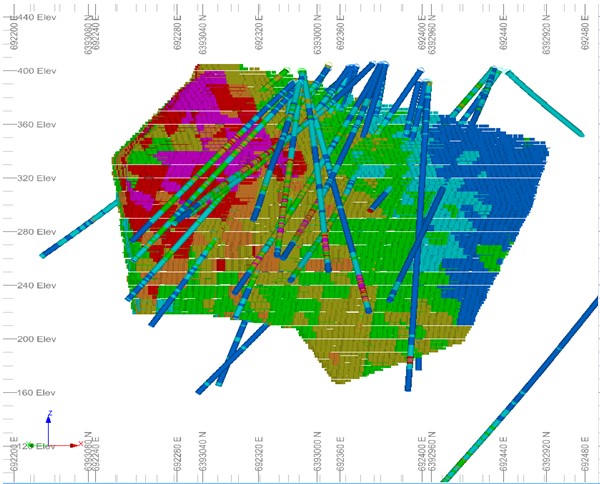
South lode long-section looking NNE
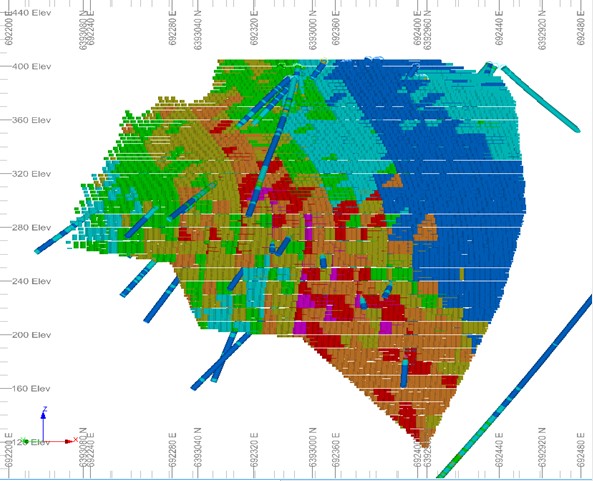
North lode long-section looking SSW
Figure 14. Resource block model of Impact’s Silica Hill discovery.
The disseminated mineralisation between the veins has helped form thick zones of near-surface modest grade mineralisation with the potential for bulk open pit mining. For example discovery hole CMIPT011 returned bonanza-grade silver within a thick zone of silver-gold mineralisation as follows:
48.6 metres at 137 g/t silver (4.4 ounces) and 0.5 g/t gold from 122 metres down hole,
including, 23 metres at 224 g/t silver (7.2 ounces) and 1.0 g/t gold from 147.7 metres,
which includes 0.9 metres at 3,146 g/t silver (101 ounces) and 2.4 g/t gold from 148.1 metres.
In addition Hole CMIPT077 returned:
22.5 metres at 1.7 g/t gold and 276 g/t silver from 166.7 metres down hole;
including 0.3 metres at 1.8 g/t gold and 4,200 g/t (135 ounces or 0.42%) silver from 174.4 metres;
and also including 0.8 metres at 13.6 g/t gold and 40 g/t silver from 187.7 metres.
And Hole CMIPT074 returned:
21.8 metres at 0.6 g/t gold and 273 g/t silver from 137.9 metres down hole;
including 0.5 metres at 0.5 g/t gold and 1,485 g/t (48 ounces) silver from 143 metres;
and 0.4 metres at 1.6 g/t gold and 6,240 g/t (200 ounces or 0.62%) silver from 148.5 metres.
Three diamond drill holes have also established that there is a low grade silver halo of up to 10 g/t silver around the Silica Hill mineralisation that is at least 500 m by 500 m in dimension (Figure 10). For example Hole CMIPT072 returned 146 metres at 0.04 g/t gold and 5 g/t silver. In addition CMIPT078 drilled at the eastern end of the northern mineralised zone returned the thickest intercept of gold and silver to date in this zone and indicates improving grades to the east and returned:
117 metres at 0.3 g/t gold and 11 g/t silver.
This attests to the scale of the mineralised system at Silica Hill which is still open in all directions and further deeper drilling is required.
NEXT STEPS

Figure 15. Conceptual model for the upper parts of porphyry copper-gold systems: most models for porphyry-to-epithermal transitions are based on work done in sub-aerial environments. In submarine environments the epithermal mineralisation may be characterised by gold rich high sulphidation volcanogenic massive sulphide deposits such as Commonwealth.
Impact’s review of its Lachlan Fold Belt portfolio has reinforced the Company’s belief that its tenements have significant prospectivity for the discovery of a major porphyry copper gold deposit. This is in addition to the potential for the discovery of further massive sulphide deposits similar to Commonwealth and which shows strong similarities to the world class Eskay Creek project in the famous Golden Triangle of British Columbia (ASX Release 13 April 2018).
Preliminary field work on some of the priority targets has already identified areas of copper-gold-silver mineralisation that require follow up soil geochemistry programmes and further synthesis and review of previous exploration data. Work thus far has focussed on the Commonwealth project but work is also required on the Pine Hill and Day Dawn projects to the south (Figure 1).
In addition research continues into the possible genetic links between porphyry copper gold mineralisation in the Lachlan Fold Belt and the unique high sulphidation massive sulphide deposit at Commonwealth. Impact has previously proposed that the Commonwealth deposit is the product of submarine venting of fluids from a buried porphyry copper system (Figure 15 and ASX Release 13 April 2018).
This is a potentially powerful model for generating new exploration targets in rocks of Lower Silurian age, extensive tracts of which are present on Impact’s licences in the region.



